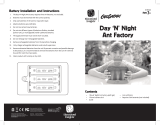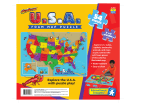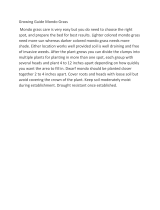Page is loading ...

Welcome!
You are about to explore the exciting world of ants. This guide gives you
detailed instructions for setting up your Ant Zone® and caring for your
ants. Fill out and mail in the enclosed Ant Certificate, along with the
required money for postage and handling, and you will receive a vial of
harvester ants (
Pogonomyrex californicus
).
Now, take a few minutes to become familiar with your Ant Zone. We
have included everything you will need for observing ants:
• Habitat with removable
lid and magnifier
• Tweezers
• Water dish
• Water dropper
Lid with Magnifier
Habitat
Sand
Tunnel Starters
Water Dish
Tweezers
Water Dropper
• Sand
• Tunnel starters
• All About Ants poster
• Ant certificate
• Guide
EI-5134
Ages 6+
Grades 1+
Developed in Southern California by Educational Insights.
© Educational Insights, Inc., Gardena, CA (U.S.A.). All rights reserved. Learning
Resources Ltd., King’s Lynn, Norfolk (U.K.). Please retain this information.
Made in China.
www.Educational
Insights.com
Fabriqué en Chine. Informations à conserver.
Made in China. Bitte bewahren Sie unsere
Adresse für spätere Nachfragen auf.
Hecho en China. Conservar estos datos.
®
Notes:
®

5. Place the Ant Zone on a sunny windowsill. As the water evaporates,
the sugar will cement the sand grains. This turns the sand into a soil
that is very much like the kind the ants are used to tunneling through.
Your ants will be able to create a complex maze of tunnels as they do
in their natural habitat.
Note: Once you put the ants in the Ant Zone, do not keep it in
direct sunlight!
2. Make Sugar Cement. This mixture, which you add to the sand, is an
important nutrient for the ants. It also makes it easier for the ants to
create their tunnels (see #5).
Pour
1
⁄
4
cup of water into a glass.
Add 1 tablespoon of white refined sugar.
Stir until all the sugar is dissolved.
3. Use the water dropper to squirt the solution
into the sand piled in the vertical walls of
the Ant Zone. Squirt two full droppers of
solution into an area, then move on to the
next section.
4. When the sand is thoroughly dampened, push
the tubular tunnel starters into the sand as far
as you can.
6. When the sand in the channel has dried,
spread the remaining sand over the surface of
the central island and dampen it with the rest
of the Sugar Cement.
7. Carefully remove the tunnel starters. Make sure you keep the tunnel
entrances clear of loose sand so the ants can have a place to start
digging.
Now your ants’ new home is ready!
2
3
Setting Up Your Ant Zone
Follow these instructions to prepare your Ant Zone. If you prepare it
before your ants arrive, they will have a comfortable home to begin
exploring right away.
1. Pour the sand into the narrow channel that
surrounds the central island of the Ant Zone.
Be sure to save the extra sand; you’ll need it later
to cover your Ant Zone’s central island.
When your ants arrive:
8. Remove the stopper and gently pour the ants into the Ant Zone. Watch
as these curious creatures quickly investigate their new home.
9. Use the tweezers to place the water dish in the sand of the central
island. Push the dish into the sand so it is just about level with the sand
surface. Use your water dropper to fill the dish to the top.
Your ants will be thirsty after their long trip, so you will want to refill the
water dish several times. When they have had enough water, the ants
will go off to explore, tunnel, and look for food. Remove the dish and
clean it off for the next use.
Place a few seeds or small pieces of granola cereal in the Ant Zone.
Place the cover over the Ant Zone and push it down carefully. Fit the
magnifier into position on the lid and snap it down gently.
Place your Ant Zone on a counter or tabletop where it won’t get direct
sunlight and won’t get knocked over.
10.
11.
12.

Ant Answers
1. How do I get my ants?
Send for your supply of ants using the Ant Certificate in this guide.
You can also find your own ants.
2. When will I receive the ants that I order?
Under ordinary conditions, you should receive your ants within three
to four weeks from the time you mail your Ant Certificate. We will send
your ants by mail upon receipt of your order. If the weather is
extremely cold, there may be a one week delay in order to protect the
ants. If you do not receive your ants within that time, call toll free
(877) 864-2207 to inquire about your ants.
3. Do many ants die when they are shipped through the mail?
Some of the ants will die during shipment. However, we consider this
when we send the shipment and send many more ants than are
needed for your habitat. If you live in a cold area, watch for the mail
delivery. You don’t want the ants waiting outside in a freezing cold
mail box.
4. Will I receive a queen with my ants?
There is a federal regulation controlling the handling of ant queens. All
the ants that we send will be workers. The workers are female ants
that cannot reproduce. Even without a queen, these ants are amazing
creatures to watch. If you find your own ants, you can look for the
queen, eggs, and larvae.
5. Is the Ant Zone escape-proof?
The Ant Zone’s escape-proof design, with its curved top edge, works
beautifully. Try to prevent ants from piling up sand near the curved lip.
This gives them the opportunity to climb out. If you keep the cover on,
they can’t escape, but you’ll want to remove it from time to time—
taking the cover off gives you an incredible opportunity to study ants
up close.
6. Is there enough air in the Ant Zone?
Yes. There are small vents built into the magnifier lid. They are too small
to allow the ants to escape, but provide plenty of air.
7. How long will my ants live?
With proper care they can live as long as six months.
ANT CARE
DDOO::
1. Give the ants fresh water every day. Natural, unchlorinated spring water
is best.
2. Give ants the sugar-and-sand mixture for their nutrition. You can also
feed your ants a small “meal” once a week. They will enjoy the inside
“meat” of sunflower seeds, dead bugs, and just about anything else.
Experiment with a few very tiny pieces of corn flakes or granola, dry
dog food, fruit tree leaves, or apple. Be sure to keep their habitat clean.
Use your tweezers to remove the leftovers from their meals.
3. Keep the Ant Zone on a counter or table. Avoid high traffic areas where
it might get knocked over. If the Ant Zone gets knocked over, pick up
the ants with the tweezers and put them back in the habitat.
4. Keep the habitat at room temperature. The temperature should stay
between 65°F and 80°F (18°C and 27°C). The warmer the
temperature, the more active the ants. They will also be more active in
darkness because it is more like their underground home.
DDOONN’’TT::
1. CAUTION: Don’t touch the ants. They may bite and sting to
protect themselves! The sting may be painful and cause
swelling, especially for those allergic to stinging insects.
2. Don’t overfeed or over-water your ants. If you overfeed the ants, the
food can go bad and this can kill your ants.
3. Don’t shake the habitat. It will disturb your ants and might destroy
their tunnels. The more careful you are, the easier it will be for your
ants to adjust.
4 5
Caution: Don’t mix ants of different species or colonies.

CAUTION: Do not release these ants into your local environment. They
could be harmful to some plants. Keep them in the habitat.
Read More About Ants
Visit your public library and discover more interesting facts about ants.
Try some of these fascinating books:
Berman, Ruth.
Ants: An Early Bird Nature Book.
Lerner Publications, 1996.
Brenner, Barbara.
Thinking About Ants.
Mondo Publishing, 1997.
Dorros, Arthur.
Ant Cities: A Let’s Read-and-Find-Out Book.
T.Y. Crowell, 1987.
Fowler, Alan.
Inside an Ant Colony
. Children’s Press, 1998.
Overbeck, Cynthia.
Ants.
Lerner Publications, 1982.
Ant Certificate
Send $4.00 ($5.00 Canada) for postage, handling, and insurance to:
Ants: Life Studies
490 S. 400 W.
Hurricane, Utah 84737
Print
Name
Print Address
Phone Age
First Name [space] Last Name
Allow 3 weeks to get your ants. After that time, call toll free (877) 864-2207 to inquire about
your ants. Please donʼt call before 3 weeks. If you do not CLEARLY and COMPLETELY fill in
the Ant Certificate and send it with the $4.00 fee ($5.00 Canada), you wonʼt get your ants.
If your ants arrive dead, call the Ant Wranglers at Life Studies.
Address Apt #
Town/City State Zip Code
Needed if handwriting is not legible.
4. Don’t put your habitat in direct sunlight. The ants may get too
hot and die. Also, be careful not to let the ants get too cold; don’t leave
them outside.
5. Don’t put any other ants in the habitat. Ants from different colonies will
fight. Each colony has a distinctive chemical scent. This is how ants in a
colony know whether or not another ant belongs to the colony.
6 7
/














